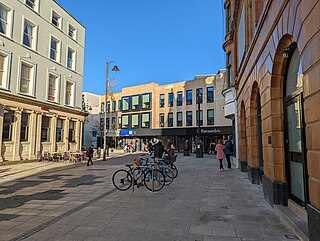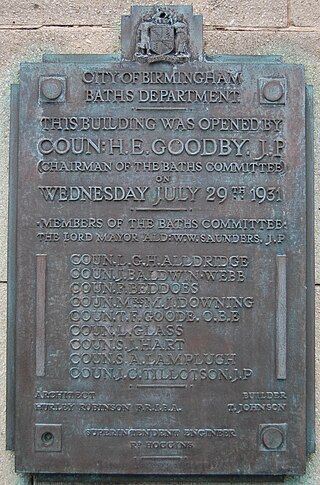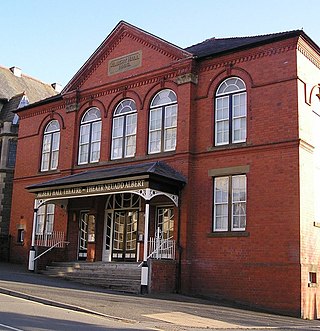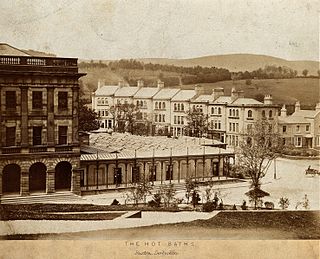
Cheltenham is a spa town and borough on the edge of the Cotswolds in Gloucestershire, England. Cheltenham became known as a health and holiday spa town resort following the discovery of mineral springs in 1716, and claims to be the most complete Regency town in Britain.

A spa is a location where mineral-rich spring water is used to give medicinal baths. Spa towns or spa resorts typically offer various health treatments, which are also known as balneotherapy. The belief in the curative powers of mineral waters goes back to prehistoric times. Such practices have been popular worldwide, but are especially widespread in Europe and Japan. Day spas and medspas are also quite popular, and offer various personal care treatments.

Saratoga Spa State Park is a 2,379-acre (9.63 km2) state park located in Saratoga County, New York in the United States. The park is in the City of Saratoga Springs, near US 9 and NY 50.

Leeds Playhouse is a theatre in the city centre of Leeds, West Yorkshire, England. It opened in 1990 in the Quarry Hill area of the city as the West Yorkshire Playhouse, successor to the original Leeds Playhouse, and was rebranded in June 2018 to revert to the title "Leeds Playhouse". It has two auditoria and a studio space, hosts a wide range of productions, and engages in outreach work in the local community.

Adelaide Festival Centre, Australia's first capital city multi-purpose arts centre and the home of South Australia's performing arts, was built in the 1970s, designed by Hassell Architects. Located on Kaurna Yarta, the Festival Theatre opened in June 1973 with the rest of the centre following soon after. The complex includes Festival Theatre, Dunstan Playhouse, Space Theatre and several gallery and function spaces. Located approximately 50 metres (160 ft) north of the corner of North Terrace and King William Road, lying near the banks of the River Torrens and adjacent to Elder Park, it is distinguished by its two white geometric dome roofs, and lies on a 45-degree angle to the city's grid.

The Erith Playhouse is a theatre in Erith, in south-east London, England. The building was originally the Oxford Cinema.

Glossop Road Baths is a building in Sheffield, South Yorkshire, England, which originally housed a swimming pool and Turkish baths.

The Birmingham Baths Committee was an organisation responsible for the provision and maintenance of public swimming and bathing facilities. Birmingham City Council funded, constructed and ran bathing facilities throughout the city. The movement to develop baths and wash houses in Britain had its impetus with the rapid urbanisation of the Industrial Revolution, which was felt acutely in Birmingham, one of England's powerhouses.

Sandford Parks Lido is a Grade II Listed heated outdoor swimming pool in Cheltenham, England. The lido consists of a 50-metre main pool, a children's pool, and paddling pool. The main pool is heated to 24-26 °C and children's pool to 30 °C. The lido is open from March until October each year for the summer season (heated) and has been open from early November until early February over the winter for cold water swimming since 2021.

The Royal Pump Rooms is a cultural centre on the Parade in Leamington Spa, Warwickshire, England. It was the most famous of several spa baths opened in Leamington between the late-18th and mid-19th centuries. People would travel from throughout the country, and indeed Europe, to benefit from treatments using the town's healing waters. When 'taking the waters' became less fashionable after the mid-19th century the Pump Rooms became Leamington's only surviving spa facility, later also being extended to include the town's public swimming pool. After a major redevelopment in 1997-99 the building now houses Leamington Spa Art Gallery & Museum, a public library, a Tourist Information Centre, cafe and assembly rooms. It is a Grade II listed building.

The Albert Hall is a period Victorian theatre in Llandrindod Wells in Powys, Wales. Originally built as a church hall in 1896, it became a theatre in 1922, with the addition of an art-deco foyer. The exterior of the building, foyer and auditorium remain to this day much as they were then.

Cleveland Pools located in Hampton Row, Bath, Somerset, England is a semi-circular lido built to designs by John Pinch the Elder in 1815. It is believed to be the oldest public outdoor swimming pool in the UK. It is a Grade II* listed building.

Everyman Theatre is a theatre based in Regent Street, Cheltenham. There are two auditoria in the building - the 718 seat main auditorium and the 60 seat Studio Theatre, originally named The Ralph Richardson Studio after Ralph Richardson.

The Beacon Arts Centre is a performing arts and community art venue in Greenock, serving the Inverclyde area of Scotland. It is owned and operated by Greenock Arts Guild Ltd., a charitable organisation with core funding from Creative Scotland and Inverclyde Council

The golden age of lidos in the United Kingdom was in the 1930s, when outdoor swimming became popular, and 169 were built across the UK as recreational facilities by local councils. Many lidos closed when foreign holidays became less expensive, but those that remain have a dedicated following. The name Lido originated from the Lido di Venezia.

The Torquay Marine Spa was a swimming bath and entertainment complex situated on a promontory overlooking Beacon Cove in the town of Torquay, Devon, England. The buildings included a ballroom, concert hall, sunlit conservatory and private bathing facilities. There was also a large public swimming bath open to the sea below these.

Jacobs Wells Baths, formally called Hotwells Public Baths, is a former public baths on Jacob's Wells Road, Bristol. Built in 1889 and designed by Bristol City Surveyor Josiah Thomas, the baths closed in the late 1970s and were converted in the 1980s into a community managed dance centre, which closed in 2016. In 2018 Bristol City Council transferred responsibility for the building to the charity Fusion Lifestyle on a 35-year lease with a peppercorn rent. The building is Grade II listed and recognised as an asset of community value by Bristol City Council.

The Buxton Baths using natural thermal spring water are in Buxton, Derbyshire, England. The baths date back to Roman times and were the basis for developing Buxton as a Georgian and Victorian spa town. The present buildings of the Thermal Baths and the Natural Mineral Baths were opened in the 1850s. They are positioned either side of the Buxton Crescent at the foot of The Slopes in the town's Central Conservation Area. They are both Grade II listed buildings designed by Henry Currey, architect for the 7th Duke of Devonshire.

The Pavilion Arts Centre was opened in 1889 as the new Entertainment Stage theatre on St John's Road in Buxton, Derbyshire, England. It is part of the Pavilion Gardens complex of buildings in the town's central Conservation Area. It has a main 360-seat theatre, and since 2017 it has been the home of Buxton Cinema.

The Ripon Spa Baths are a grade II listed building in Ripon, North Yorkshire, England. It was built between 1904–05 as a spa but failed to compete with the larger facilities at nearby Harrogate. In 1936 a new pool was constructed to the rear and the facility converted to a swimming baths. The building is noted for its ornate terracotta-clad frontage and received listed building protection in 1980. Harrogate Borough Council proposed selling the building for housing development in 2008 on the grounds that it required significant structural repair. The sale was cancelled but in 2021 the council made a new proposal to sell the structure.





















